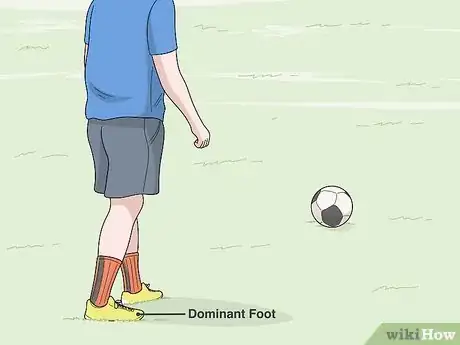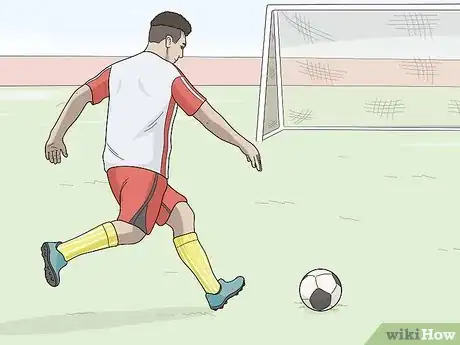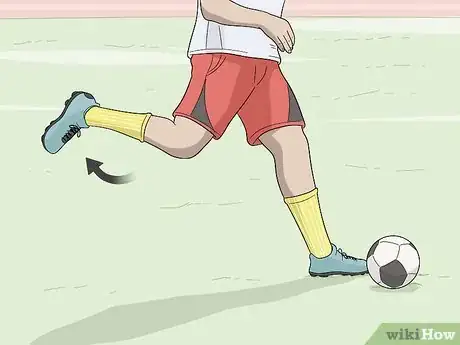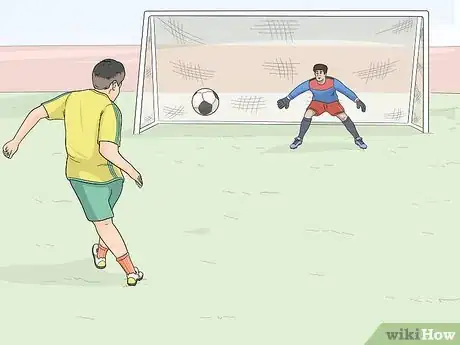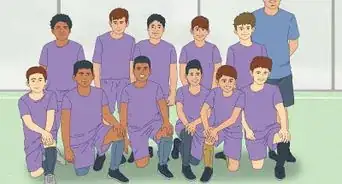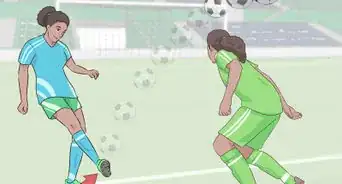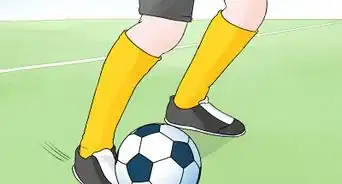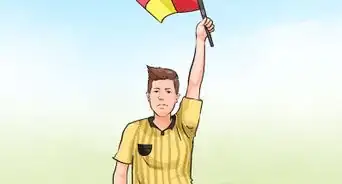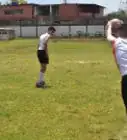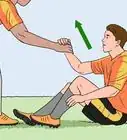This article was co-authored by Misty Benson. Misty Benson is a Soccer Coach and Academic Specialist in Plano, Texas. She has been the head coach of high school soccer teams since 2003 and the Coordinator for US Soccer National Teams since 2013. She has a Master’s Degree in Educational Administration from Texas A&M-Commerce.
wikiHow marks an article as reader-approved once it receives enough positive feedback. In this case, 80% of readers who voted found the article helpful, earning it our reader-approved status.
This article has been viewed 321,549 times.
Have you ever wanted to score a goal in your soccer game but felt that your shot was too weak? Most likely your kicking technique needs to be adjusted. Simple mechanical adjustments help you generate long kicks with power and precision, helping you take that shot or pass to your teammates far up the field. To kick a soccer ball with power, shorten your stride, strike the middle of the ball with the top of your foot, and follow through the swing.
Steps
Approaching the Ball
-
1Set the ball up for your dominant foot. During a free kick when you strike a stationary ball, angle yourself to prepare to kick the ball with your stronger foot. Otherwise, when dribbling with the ball, push the ball ahead of you and towards your kicking foot.
- Shift yourself and the ball to get the proper kicking angle. For example, when kicking the ball with your right foot, shift your body to the left or while running push the ball ahead so it is in front of your right big toe.
- Contacting the ball slightly to the right or left of center will generate full contact with less sway than a strike dead-center.
-
2Take short strides. As you approach the ball for the kick, shorten your strides. This is simplest to do when the ball is set and can be seen when professional players take free kicks. During a run, quickly shorten your strides right before you choose to shoot for more power and control.[1]Advertisement
-
3Plant your non-kicking foot next to the ball. Continue running until you reach the ball. The foot you’re not using to strike the ball needs to be set right next to the ball, not behind it. This brings your body over the ball. If you stay behind the ball, you will have a tendency to lift the ball and miss the target or hit the ball with your toe.[2]
-
4Point your non-kicking foot in the direction you want the ball to go. As you plant your non-kicking foot, point it in the direction you want the ball to go. Pointing your foot the wrong way makes kicking feel awkward, prevents you from maximizing your power, and can send the ball in a direction you did not intend for it to go.
- Pointing your foot towards the ball will cause your foot to get in the way. Point too far to the side and you’ll lose control of the ball.
-
5Look down at the ball. Right before you kick it, glance down at the ball. Focus on kicking with the proper technique instead of generating power or watching the spot you want the ball to hit. This will help you keep your body over the ball and prevents you from lifting the ball.
Kicking the Ball
-
1Relax your body. Many people focus too much on generating power. When you do this, you force your shot, losing control of the ball and losing power because of a poor strike. Instead, let your body drop so that your shoulders are squared and the only tension is in your ankle.[3]
- Sometimes players shake out tension before taking a free kick.
-
2Bring your leg back. Bend your non-kicking knee slightly as you draw your kicking leg back. Don’t go too far back or else you won’t be able to swing your leg forward quickly to get the ball away with accuracy.
- Large swings are best for long-distance kicks.
-
3Point your toes towards the ground. When you move your kicking leg backward, angle your toes downwards. This causes your ankle to lock.[4]
-
4Bring your leg forward. Whip your leg forward towards the ball. Keep your foot angled downwards as you do this. Right before you strike the ball, extend your foot to unleash the power stored in your leg
-
5Make contact with the knuckle of your big toe. Coaches tell you to kick the ball with the laces of your foot. Technically, you are kicking below that. The knuckle is where your big toe connects to the rest of your foot. This large bone creates force when the area just above it strikes the ball. Watch the ball as your foot connects with it.[5]
- Never kick with your toes. This not only generates less power and control, but it can hurt your toes.
- Hit the ball halfway up from the ground for maximum power. Strike further to the sides for more spin.
Following through Your Shot
-
1Swing through the ball. Don’t stop when your foot hits the ball. Move your foot through the ball as it leaves your foot. This ensures your leg’s momentum is fully expended on the ball. Your foot will raise up at the end of the swing’s arc.
-
2Land on your kicking foot. Bring your foot down and plant it on the ground first before you try to move. That way the momentum of your swing is maximized and you stabilize yourself as you try to move.[6]
-
3Follow up your shot. If possible, run after your shot. Putting pressure on your opponent may cause them to deflect or drop the ball, giving you a chance to follow your shot and potentially score.
Community Q&A
-
QuestionHow can I get more power behind my shots?
 Community AnswerPractice shots on your own and watch videos on shooting. Practice dribbling with speed and shooting. You should always know where you are from the goal before taking a shot. Make sure the foot you are not shooting with is close to the ball, and strike the ball in the middle with a kick from the hard part of the bridge on your foot.
Community AnswerPractice shots on your own and watch videos on shooting. Practice dribbling with speed and shooting. You should always know where you are from the goal before taking a shot. Make sure the foot you are not shooting with is close to the ball, and strike the ball in the middle with a kick from the hard part of the bridge on your foot. -
QuestionAre there more steps on how to kick a ball?
 Community AnswerYes. It is more natural for a player to kick the ball when she/he walks up to the ball before kicking it. For example, if a ball is at your feet, it is very difficult to get any serious power. Push/tap the ball forward several feet in front of you, then walk up to it and kick it.
Community AnswerYes. It is more natural for a player to kick the ball when she/he walks up to the ball before kicking it. For example, if a ball is at your feet, it is very difficult to get any serious power. Push/tap the ball forward several feet in front of you, then walk up to it and kick it. -
QuestionWhat shot results in the most power?
 JR~325Community AnswerKicking with the big toe knuckle gives you a more powerful shot, since it is the largest bone in your feet. Make sure you get good contact on the ball.
JR~325Community AnswerKicking with the big toe knuckle gives you a more powerful shot, since it is the largest bone in your feet. Make sure you get good contact on the ball.
Warnings
- Do not strike the ball with the tips of your toes. This hurts and can even cause a broken bone.⧼thumbs_response⧽
References
- ↑ http://soccerhelp.com/kick-shoot-soccer-ball.shtml
- ↑ http://soccerhelp.com/kick-shoot-soccer-ball.shtml
- ↑ http://www.active.com/soccer/articles/6-steps-to-a-more-powerful-shot
- ↑ http://www.footy4kids.co.uk/soccer-drills/ball_control/how-to-stop-children-kicking-a-soccer-ball-with-their-toe/
- ↑ http://www.active.com/soccer/articles/6-steps-to-a-more-powerful-shot
- ↑ http://www.onlinesocceracademy.com/soccer-training-videos/shooting/how-to-shoot-a-soccer-ball-with-power/
About This Article
To kick a soccer ball hard, shorten your stride as you approach the ball to give your leg swing power and control. Then, take a small hop forward at the end of the last stride. Plant your non-kicking foot next to the ball so your body is centered, which will help your aim as well as your foot strike. Prepare to kick by bringing your dominant foot back and pointing the toe down to lock the ankle. Finally, extend your foot forward and kick the ball with your big toe's knuckle. For tips on how to follow through with your shot, keep reading!
